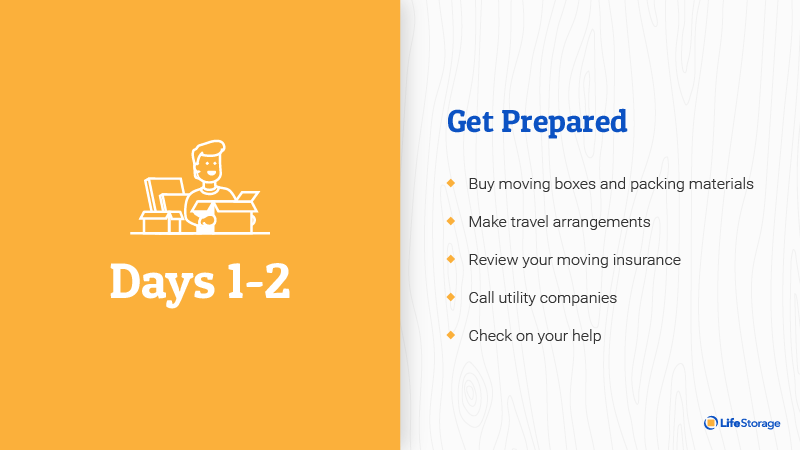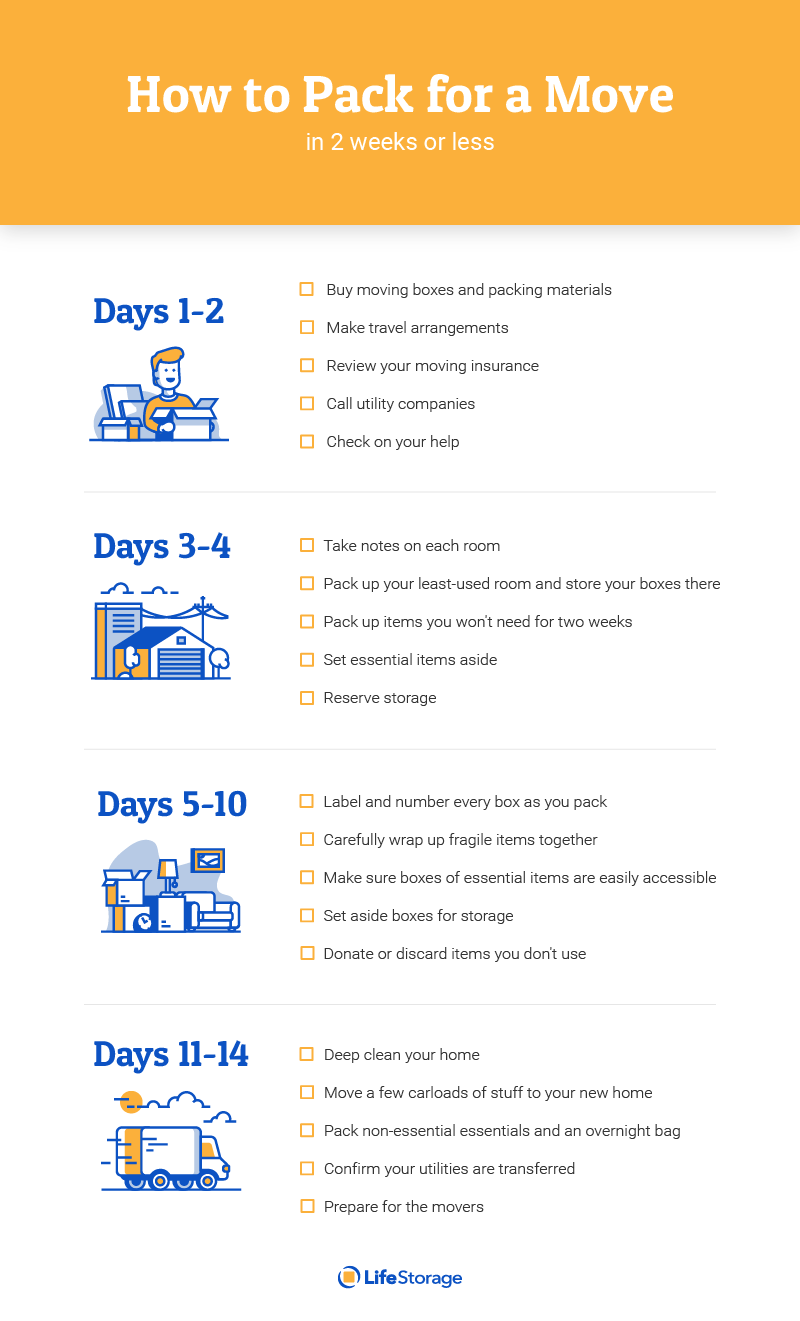No one on the planet looks forward to moving. Every part of the process, from the packing, to the logistics and manual labor required to move, is taxing and overwhelming.
For most of us, the moving process has to happen while we’re juggling other responsibilities and aspects of our lives, including full-time jobs, kids, and pets. There’s no getting around it – moving sucks. But, it doesn’t have to be quite as terrible as it seems.
The key to packing for a move is having a strategy. There are tons of things that need to get done, but if you approach the process in a thoughtful and systematic way, you’re much more likely to stay calm and less likely to forget something important. In the steps below, we’ve laid out a game plan that will help get you ready for a move in 2 weeks or less:
Step 1: Get Prepared – Days 1-2

Buy moving boxes and packing materials. As soon as you’ve decided to move, you’ll need to plan out the transition from your old home to your new one. Packing is a major part of that process and you’re going to need moving supplies.
Start off by stocking up on the following packing materials:
- Moving boxes
- Bubble wrap
- Packing paper
- Moving blankets and furniture pads
- Stretch plastic wrap
- Heavy-duty packaging tape with a tape gun
- Permanent markers
- Trash bags
- Ziploc bags
- Mattress bags
Make travel arrangements. Arrange for a place to stay if your new home isn’t ready to be moved-in right away. It can be at a hotel, with a friend, or at a family member’s house, but you’ll want to find a low-stress place to stay.
Review your mover’s insurance. Most homeowner’s insurance policies don’t cover your property while it’s in transit, meaning for the entirety of the move, whether it’s around the corner or a cross country shipment, your belongings have no protection. Consider buying moving insurance if you would like to be compensated for either repairs or replacement.
Call utility companies. Transfer your utilities from one address to another online or by phone. Make sure to do it early in this process to avoid having a problem with your electricity or water later. Also, you’ll want to call to confirm a few days before the move.
Get help. Let your friends and family know which day you’re moving, offer them free pizza and cold beverages, and look into hiring professional movers. It’s unlikely that you will be able to handle moving all of your belongings by yourself, but if you live in a small apartment, you might be able to handle it with a few pairs of willing hands. It’s worth hiring professional help if you have a lot of heavy furniture items or a house full of stuff. You’ll want to avoid getting your furniture accidentally damaged by inexperienced friends and family.
Step 2: Get Organized – Days 3-4

It’s time to start packing strategically. Follow these steps:
- Walk through your existing home and take notes on each room. Think about how the items in each room will translate to your new home. This will help you pack systematically and keep relevant items together.
- Start packing rarely used items that you want to hang onto but won’t need within the next two weeks. Purge your home of anything you don’t need or use regularly. The more you donate or discard, the less you’ll need to worry about on moving day.
- Identify essential items that you will need right up to the very last minute and set them aside. This could include cooking utensils, clothing, toiletries, and other essentials.
- Pack up your least-used room and store your boxes there.
- Reserve storage. You can rent a storage unit near you to store items until you have a permanent plan for them.
Step 3: Start Packing – Days 5-10

Once you’ve identified the absolute essentials for your remaining time in your home, you are ready to go through and actually start packing up your stuff. You’ll want to do this carefully because eventually, you’ll need to find everything again! It’s good to plan for 1 or 2 full days of packing over a weekend for instance to power through the major rooms.
- Pack anything you have decided is not essential for your remaining time in the house. Make a note of which room each box goes to and label the box with a number. At the end of the process add the total number of boxes for each room so you know if one is missing. For instance, if there are eleven boxes from the kitchen, label each box “Box 1 of 11”, “Box 2 of 11”, etc.
- Donate and discard items you don’t really need or use. Use this opportunity to KonMari your life and get rid of anything that might have survived your initial spring cleaning, but isn’t important enough to pack.
- Pack carefully. Use bubble wrap, packing paper, and furniture bags to protect your belongings. Keep breakable items together as much as possible and make sure to label them as “Fragile”.
- Anything that needs to be taken apart (TV stands, shelving, kitchen appliances, etc.) should be kept together with all of their parts. Use plastic bags to keep any screws together and tape them to the item.
- Identify items going to storage that you don’t need right away or don’t have space for. Make sure to label them as such and set them aside.
Step 4: Finalize – Days 11-14

Once you’re completely packed, it’s time to get ready for moving day!
- Deep clean the house or apartment. Mop the floors, clean out the refrigerator, and do all of those cleaning jobs that you couldn’t do when your home was filled with stuff. Because now, it isn’t!
- Make a couple of trips to your new home, if possible. Moving everything you own from one place to another in one day can be very overwhelming. Take a few carloads of stuff over to your new place. It will help you feel productive and cut down on the amount of stuff that has to be moved on moving day.
- Pack the non-essential essentials. Any cooking utensils, clothing, or toiletries that you no longer need can be packed up.
- Pack an overnight bag for your first night. You don’t want to have to fish your toothbrush out of one box, try to find sheets in another, and struggle to remember which box has clean underwear. Pack an overnight bag with bedding, toiletries, and a fresh change of clothes so you have everything you need in one place when you’re trying to avoid walking into boxes the next day.
- Confirm that your utilities are transferred over to your new home.
- If you hired professional help, get bottled water and cash to tip. If your friends and family are expecting to be fed, get snacks, water, and schedule the pizza delivery.
- Make sure that you’ve compiled things you’ll need immediately into easily accessible boxes. Have plenty of cleaning supplies, since you’ll likely want to clean the cabinets out before you start putting things in them. Make sure you have toilet paper so people can use your bathroom, towels for washing your hands, etc.
And there you have it! You’ve packed for a move in two weeks or less, everyone is still standing, and your entire life has been moved from one place to another. Of course, you don’t have to follow this schedule for managing your move. Spreading out the steps will make everything more manageable and a little less frantic.
However, if you are in a time crunch, these are the steps you can take to tackle a move without feeling like you’re forgetting anything major. And of course, Life Storage is here to meet all of your storage needs every step of the way.







